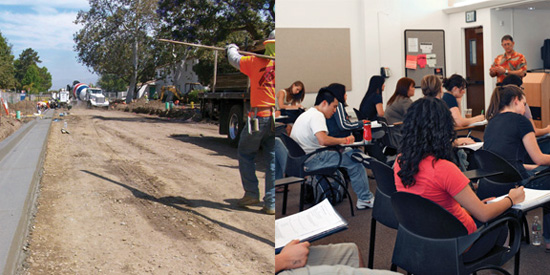Bridging the Gap
State budget cuts challenge CI Community
By Lori Putnam

California’s $24 billion state budget deficit hit home this summer when it was announced that the California State University system would face a $584 million cut in public funding. In response, the CSU Board of Trustees announced for academic year 2009/2010 increases in student fees of up to $828 per student, an employee furlough of most of the system’s 47,000 employees, as well as an enrollment reduction of 40,000 students over the next two academic years.
“There has never been such a steep drop in state support in such a short amount of time,” said CSU Chancellor Charles B. Reed as part of the July 2009 announcement of the Trustees’ plan to bridge the funding gap. “We are in the midst of a financial meltdown and need to take immediate action in order to preserve our institutions.”
As the youngest member of the CSU system, CI has been on a trajectory of steady growth and rising reputation since it welcomed its first students in 2002. The Chancellor’s announcement which required CI employees to take two unpaid days of leave per month has created significant challenges for the University. The only exception to furloughs were CSU public safety personnel and SETC union members who voted in favor of layoffs.
“The budget cuts have affected us in that they have slowed our growth,” observed President Richard R. Rush. In addition to the furloughs and increased student fees, the University has been unable to hire new faculty and has had to slow capital construction projects. “On the positive side, the Chancellor has allowed our enrollment to remain flat. At our stage of growth, it would be a detriment for the University to cut back on student numbers,” added President Rush.
Although the University will not be accepting any new undergraduate students for spring 2010, Jane Sweetland, Dean of Enrollment, said the University has many more applicants for fall 2010 than the campus can accommodate. “Partly because we could not take new students in the spring, we have seen a major surge of applicants for fall. We recommended to everyone that they apply early and get their documentation in on time,” said Sweetland. “In addition, the increased student fees and rocky economy have affected students’ ability to pay.”
“Everyone is asked to attend to the hard work of having a positive attitude during these difficult times,” said President Rush. “Our goal is to move forward with innovative ideas so when the economy does change, not only are we ready, but we will have been making progress.”
And the CI community has responded. A University fund with donor contributions has been developed to assist employees facing significant financial hardships and University faculty are seeking ways to streamline their work without impacting the learning of their students. “I will tell you something: of all the institutions that I’ve been a part of, this is the most dedicated group of faculty,” observed Provost Dawn Neuman. “They are really concerned about their students.”
For Dr. Craig Seabaugh, a Biology lecturer, increased class sizes have impacted his teaching but not necessarily the students’ learning. “My teaching style has become more didactic and lecture-centric,” he said. “On a positive note, many students seem to be embracing, out of necessity, greater responsibility for their own intellectual advancement. They are seeking opportunities to investigate and learn on their own.”
For example, despite the impact on campus, CI students continue to reach out to the greater Ventura County community. CI Sociology students are currently volunteering with Schools on Wheels to tutor homeless children. The Los Angeles-based nonprofit organization tutored more than 2,000 students in Southern California last year alone.
What is the future of higher education in California? President Rush asks members of the community to let the legislature know how important CI is to the region and its workforce. “It appears as though the legislature is placing education low on the priority list, instead of recognizing that education is an investment in the future of California, its workforce, its quality of life, its international economic competitiveness,” concluded Rush.
